New Components to Prevent Battery Fires at the Cell Level
META® is developing two new components, suitable for all chemistries and formats of lithium-ion batteries, to provide increased safety, efficiency, and sustainability. In combination, we believe these two components can make batteries much safer at the cell level, and save extra cost, weight, and materials in the pack. NPORE® nano-ceramic battery separators are uniquely heat stable, to help inhibit thermal runaway, which leads to battery fires. NCORE™ polymer composite thin copper current collectors eliminate about 85% of copper content, reducing weight and thickness, improving energy density and vehicle range, with a fuse-like feature for increased safety. Lighter batteries allow vehicles to make more efficient use of whatever energy source is used to charge them, and less copper content reduces emissions from battery production and energy used for recycling. In this post, we examine the problem of li-ion battery fires and propose ways to prevent them.
Lithium-ion batteries are already ubiquitous in our daily lives, powering smartphones, laptops, and cordless tools and appliances. As the transportation sector transitions from internal combustion engine (ICE) vehicles to EVs (electric vehicles), IDTechEx projects that the market will grow at a 25% CAGR from 2021 to 2033, reaching 5870 GWh. However, battery fires remain a risk for both small and large-sized Li-ion batteries. Ford recently halted production of the popular F150 Lightning pickup after a battery fire. In early February, four people were hospitalized after a laptop battery fire on a United Airlines flight. For battery and device/vehicle OEMs, the cost and reputational risk of fires and related recalls can be quite significant.
Let’s dig a little deeper into what causes battery fires – a phenomenon known in the industry as thermal runaway – which occurs in three stages:
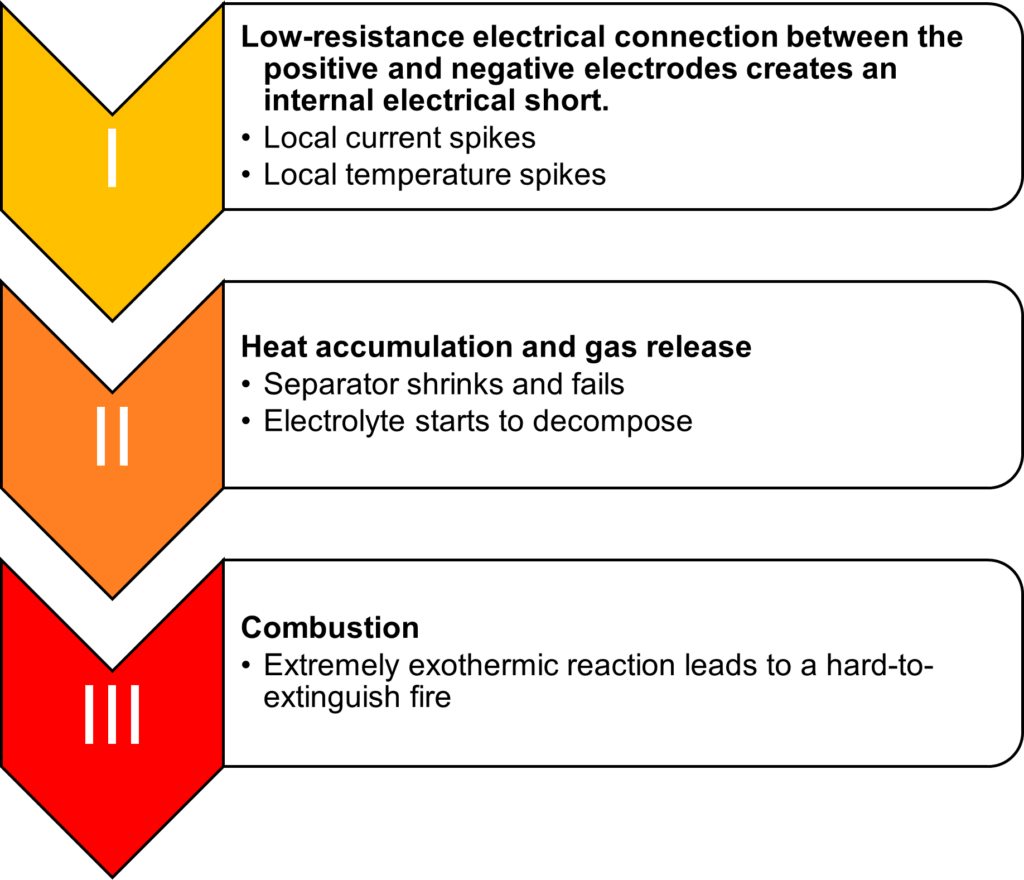
Three Stages of Thermal Runaway
The most common cause is when a defect between the electrodes creates an internal short. This might be a particle of metal from the manufacturing process or a lithium metal dendrite that penetrates the separator. Overcharging and external abuse can also lead to thermal and mechanical stresses that may cause a runaway.
- In stage 1 – local current and temperature spike
- In stage 2 – accumulation of heat and gas cause the typical industry separator to shrink and fail. The electrolyte starts to decompose.
- In stage 3 – the defect rapidly enlarges, generating even more high current and heat, and an intense fire ensues.
While EV battery fires are less common than fires in ICE vehicles, EV battery fires release Mega-Watt levels of intense heat (>600 ° C) for hours and can reignite even days later. When firefighters in Wakefield, MA were attempting to remove an EV that was hung up on a guardrail after a crash, the resulting fire required hours and more than 20,000 gallons of water to extinguish. Burning a single, medium-sized EV battery can release 1.5 Kg of toxic HF gas. Because the problem is so serious, various pads, gels, coatings, and foams added to EV battery packs are intended to help slow the spread of heat and fire from one cell to others in the pack. The market for battery fire protection materials is already over $1B.
META® Cell-Level Solution
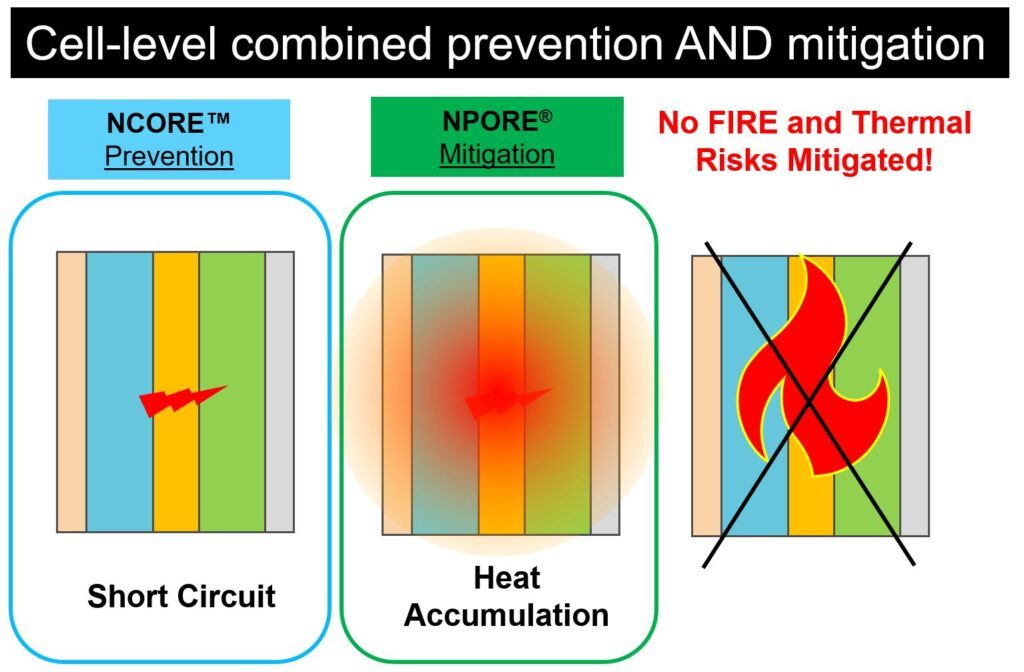
META® Cell-Level Solution
NCORE™ – Lighter Weight and Fuse-Like Safety Feature
NCORE™ metal-polymer composite current collectors replace traditional solid metal foils and offer the world’s first through-plastic-core conductivity. Typical current collectors made of solid copper foil are heavy, accounting for more than 10% of the weight of the battery cell and range from 8-12 microns thick. NCORE™ reduces weight by about 85% for the current collector, and 5% at the cell level, and thickness is just 6.5 µm. Reduced weight and thickness increase energy and power densities and extend vehicle range. A thin plastic material is embedded with metal from both sides, using META’s proprietary PLASMAfusion® vacuum deposition technology. This creates metal layers on the top and bottom, and metal bridges that conduct current through the material from one side to the other. If the local current gets too high, because of a short, the plastic material melts, destroying the bridges and acting like a fuse to shut down the current at that location.
NCORE™ Metal-Polymer Composite Current Collector
NCORE™ Outperforms Alternatives
Solid copper foil current collectors are thicker and much heavier compared to NCORE™. Lower elongation to break strength can be an issue with the high-speed roll-to-roll manufacturing equipment used for electrode coating. Metal coated plastic substrates reduce the weight of copper, but do not provide through conductivity, and pose difficulties with tab welding and high production cost. NCORE™ offers high through conductivity, critical for battery performance, a fuse-like safety feature to inhibit thermal runaway, better elongation to break strength vs. copper foil, and NCORE™ can be assembled with standard tab welding. It is important to highlight that META’s unique PLASMAfusion® technology provides low manufacturing cost.
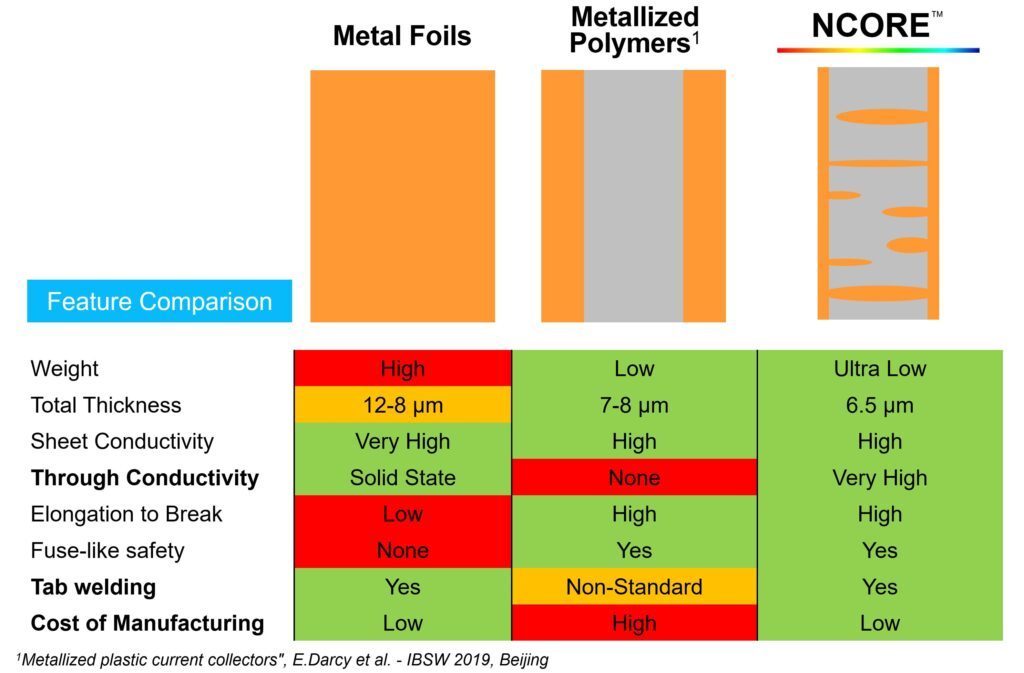
Current Collectors Feature Comparison
Developing NCORE™ Roll-to-Roll Production
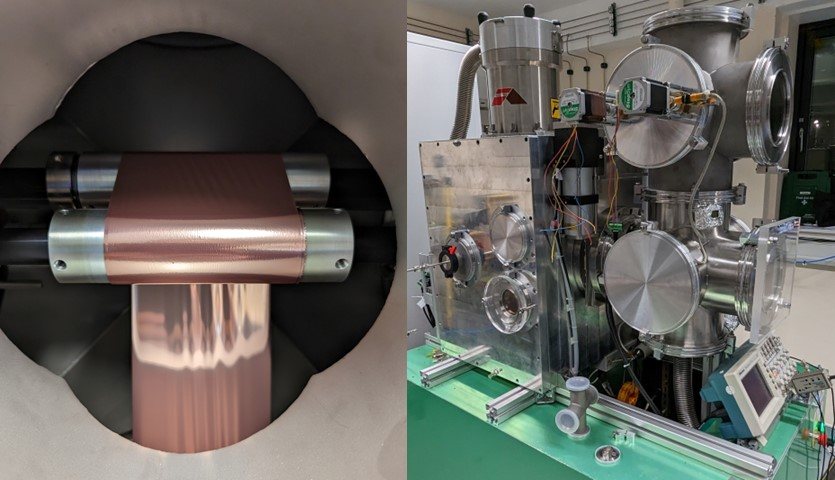 Gen2 Mini R2R PLASMAfusion® System and Sample Output
Gen2 Mini R2R PLASMAfusion® System and Sample Output
Together with our partners, DuPont Teijin Films and Mitsubishi Electric, we are developing roll-to-roll capabilities to industrialize NCORE™ production. Pictured here is our second generation mini R2R system producing 10 centimeter wide by 20-meter-long rolls. We are focused on improving material handling, deposition rate (which is closely related to thermal management), and process control. We will develop a pilot-scale system, followed by industrial-scale equipment, and then apply PLASMAfusion® to solid state battery production. We will also be presenting and exhibiting at upcoming battery conferences and tradeshows.
NPORE® – Preventing Thermal Runaway
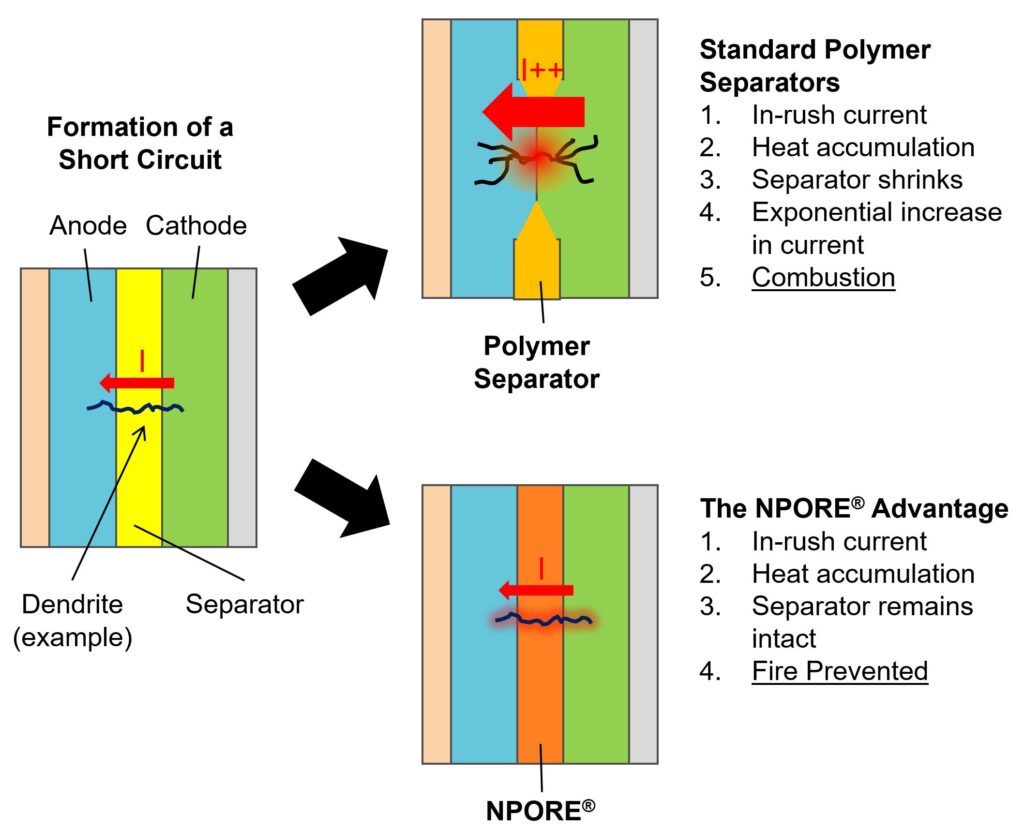
NPORE® Prevents Thermal Runaway
NPORE® is the world’s first flexible, freestanding ceramic nanoporous membrane separator for Li-ion batteries. The battery separator acts as an insulating membrane between the two electrodes. It must allow the ions to pass back and forth during charging and discharging but keep the two electrodes from contacting. NPORE® has less than 1% heat shrinkage up to 200° C, with best-in-class dimensional stability. The diagrams above illustrate what happens when there is an internal short. A standard polymer separator shrinks, fails, and causes thermal runaway. NPORE® remains intact and prevents a battery fire. The pictures below show the results of a nail penetration test, with two cells made from identical materials, except for the separator. A nail driven through the NPORE® cell leaves a hole, but the cell temperature never exceeds 55° C, and when the nail is removed, the cell voltage recovers and continues stable operation. When a nail penetrates the cell with a standard polymer separator, the voltage drops to zero, cell temperature shoots up to 700° C, and the cell is destroyed.
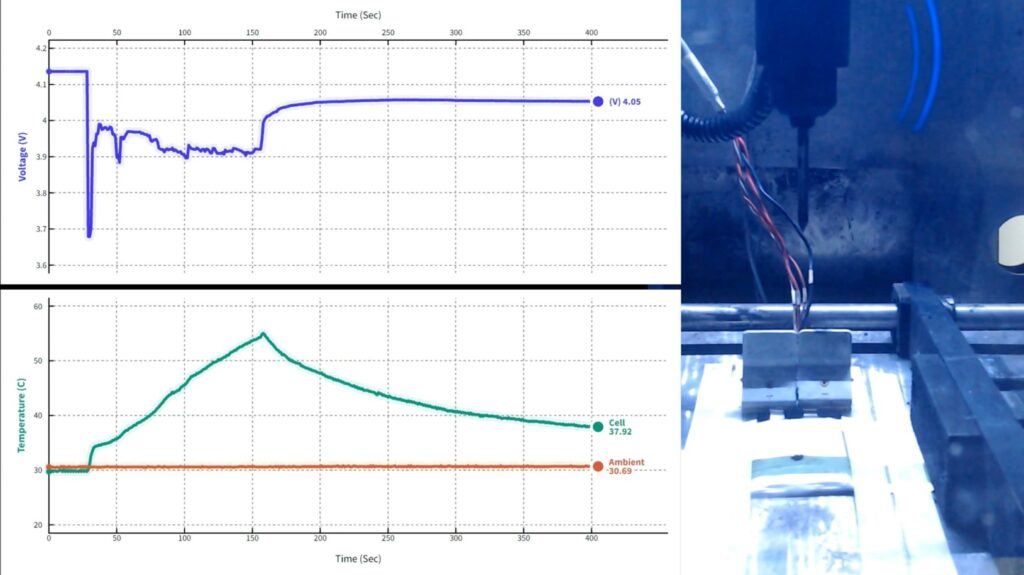
NPORE® Separator
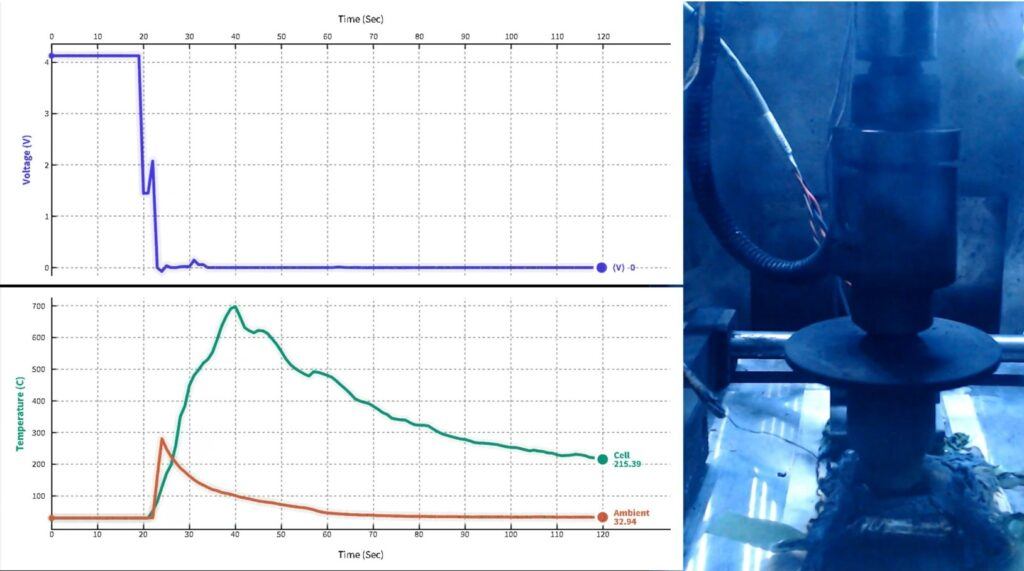
Standard Separator
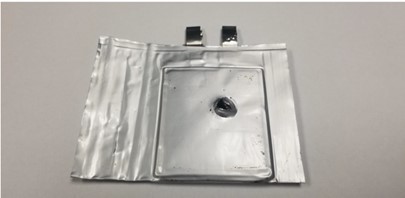 |
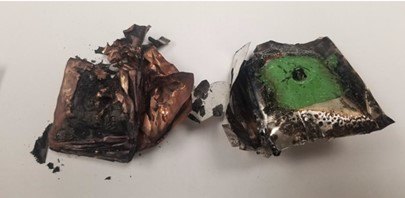 |
| NPORE® Cell Survives Nail Penetration | Standard Polymer Cell is Destroyed |
NPORE® offers very narrow and uniform pore size distribution, which is tailorable for different applications. Life cycle testing of 5-Ah pouch cells with NPORE® shows a stable and long cycle life. We plan to scale up NPORE® via outsourced production, for which high-volume capacity is available.
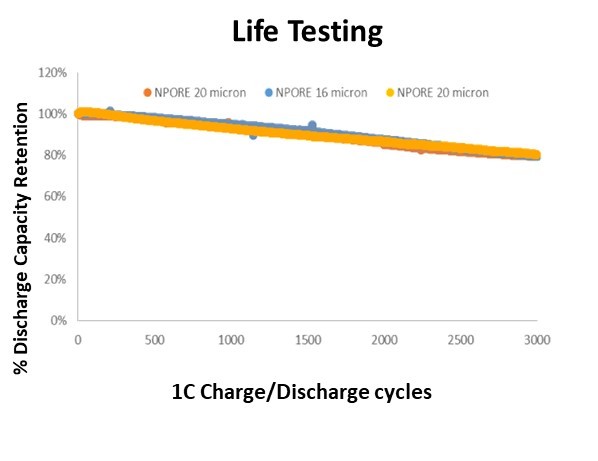
NPORE® NMC/Graphite Chemistry Life Testing |
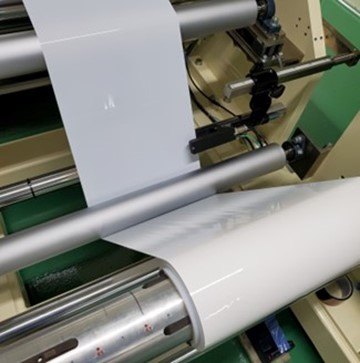
|
To learn more about META’s new battery components, please contact: sales@metamaterial.com
